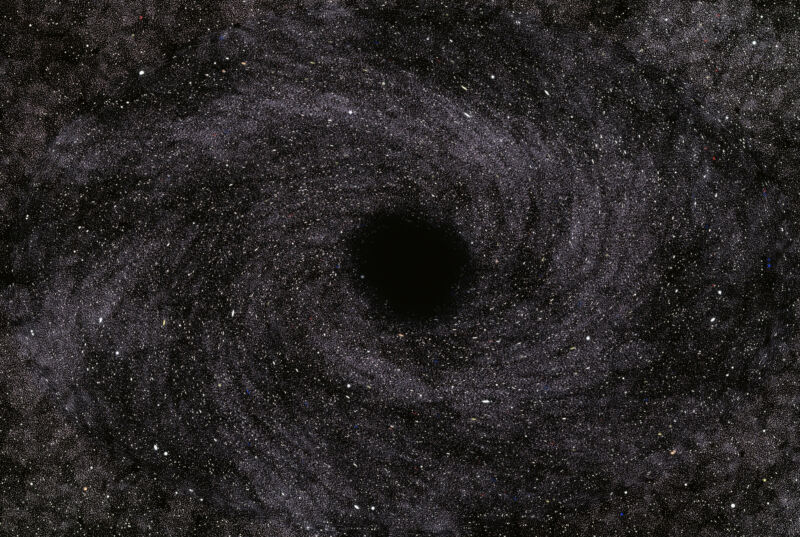Black Holes Can’t Trash Info About What They Swallow

Three numbers.
Just three numbers—that’s all it takes to completely, unequivocally, 100 percent describe a black hole in general relativity. If I tell you the mass, electric charge, and spin (i.e., angular momentum) of a black hole, we’re done. That’s all we’ll ever know about it and all we’ll ever need to describe its features.
Those three numbers allow us to calculate everything about how a black hole will interact with its environment, how objects around it will respond to it, and how the black hole will evolve in the future.
For all their ferocious gravitational abilities and their unholy exotic natures, black holes are surprisingly simple. If I give you two black holes with the exact same mass, charge, and spin, you wouldn’t be able to tell them apart. If I swapped their places without you looking, you wouldn’t know that I did it.
This also means that when you see a fully formed black hole, you have no idea what made it. Any combination of mass squeezed into a sufficiently small volume could have done the job. It could have been the ultra-dense core of a dying star. It could have been an extremely dense litter of adorable kittens squashed into oblivion.
As long as the mass, charge, and spin are the same, the history is irrelevant. No information about the original material that created the black hole survives. Or does it?
Founding charters
“Information” is a bit of a loaded term; it can take on various definitions depending on who you ask and what mood they’re in. In physics, the concept of information is tightly linked to our understanding of how physical systems evolve and how we construct our theories of physics.
We like to think that physics is a relatively useful paradigm for understanding the Universe we live in. One of the ways that physics is useful is its power of prediction. If I give you a list of all the information about a system, I should be able to apply my laws and theories of physics to tell you how that system will evolve. The reverse is also true. If I tell you the state of a system now, you can run all the math backward to figure out how the system got to its present state.
These two concepts are known as determinism (I can predict the future) and reversibility (I can read the past) and are pretty much the foundational core of physics. If our theories of physics didn’t have these properties, we wouldn’t be able to get much work done.
These two concepts also apply to quantum mechanics. Yes, quantum mechanics puts strict limits on what we can measure about the Universe, but that doesn’t mean all bets are off. Instead, we can simply replace a sharply defined classical state with a fuzzier quantum state and move on with our lives; the quantum state evolves according to the Schrödinger equation, which upholds both determinism and reversibility, so we’re all good.
Information is not lost when you burn a book; it’s merely scrambled.
This one-two punch of determinism and reversibility means that, in terms of physics, information must be preserved during any process. It can’t be either created or destroyed—if we were to add or remove information willy-nilly, we wouldn’t be able to predict the future or read the past. Any loss or gain means there would either be missing information or extra information, so all of physics would crumble to dust.
There are many processes that appear to destroy information, but that’s only because we’re not keeping careful enough track. Take, for example, the burning of a book. If I gave you a pile of ashes, this would appear to be irreversible: There’s no way you could put the book back together. But if you have a sufficiently powerful microscope at your disposal (and a lot of patience) and got to watch me in the act of burning the book, you could—in principle at least, which is good enough—watch and track the motion of every single molecule in the process. You could then reverse all those motions and all those interactions to reconstruct the book. Information is not lost when you burn a book; it’s merely scrambled.
In the traditional, classical view of black holes, all this business about information is not a problem at all. The information that went into building the black hole is simply locked away behind the event horizon—the one-way boundary at the black hole’s surface that makes it so unique. Once there, the information will never be seen in this Universe again. Whether the black hole was formed from dying stars or squashed kittens, it doesn’t practically matter. The information may not be destroyed, but it’s permanently hidden from our prying eyes.
READ MORE HERE
